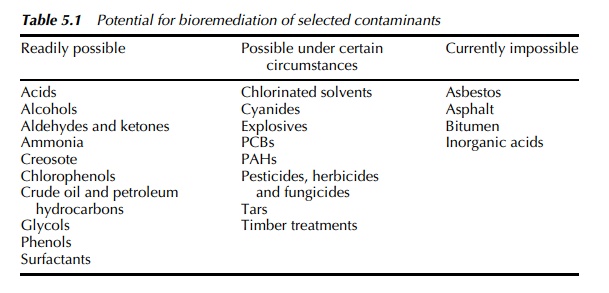Chapter: Environmental Biotechnology: Contaminated Land and Bioremediation
Suitability of Bioremediation
The Suitability of
Bioremediation
Bioremediation as a biotechnological intervention for cleaning up
the residual effects of previous human activities on a site, typically relies
on the inherent abilities and characteristics of indigenous bacteria, fungi or
plant species. In the present discussion, the emphasis will concentrate on the
contribution made by the first two types of organism. The use of plants,
including bioaccumulation, phytoextraction, phytostabilisation and
rhizofiltration, all of which are sometimes collectively known as
phytoremediation. Thus, the biological mechanisms underlying the relevant
processes are biosorp-tion, demethylation, methylation, metal-organic
complexation or chelation, ligand degradation or oxidation. Microbes capable of
utilising a variety of carbon sources and degrading a number of typical
contaminants, to a greater or lesser extent, are commonly found in soils. By
enhancing and optimising conditions for them, they can be encouraged to do what
they do naturally, but more swiftly and/or efficiently. This is the basis of
the majority of bioremediation and proceeds by means of one of the three
following general routes.
Mineralisation, in which the contaminant is taken up by microbe
species,used as a food source and metabolised, thereby being removed and
destroyed. Incomplete, or staged, decomposition is also possible, resulting in
the generation and possible accumulation of intermediate byproducts, which may
themselves be further treated by other micro-organisms.
Cometabolism, in which the contaminant is again taken up by
microbes butthis time is not used as food, being metabolised alongside the
organism’s food into a less hazardous chemical. Subsequently, this may in turn
be mineralised by other microbial
species.
Immobilisation, which refers to the removal of contaminants,
typically met-als, by means of adsorption or bioaccumulation by various
micro-organism or plant species.
Unsurprisingly, given the
expressly biological systems involved, bioremedi-ation is most suited to
organic chemicals, but it can also be effective in the treatment of certain
inorganic substances and some unexpected ones at that. Met-als and
radionuclides are good examples of this. Though, obviously, not directly
biodegradable themselves, under certain circumstances their speciation can be
changed which may ultimately lead to their becoming either more mobile and

accessible or less so. The net result produced in either case can,
under the right conditions, be a very effective functional remediation. A list
of typical contam-inants suitable for bioremediation would include the likes of
crude oil and its derivatives, some varieties of fungicides and herbicides,
hydrocarbons, glycols, phenols, surfactants and even explosives.
Developments in
bioprocessing continually redefine the definitive catalogue of what may, and
may not, be treated and many chemicals once thought ‘impossible’ are now
routinely dealt with biologically. Table 5.1 reflects the current state of the
art, though this is clearly subject to change as new approaches are refined.
As a result, it should be
obvious that a large number of opportunities exist for which the application of
remediating biotechnologies could have potential relevance. Even so, there are
a number of factors which affect their use, which will be considered before
moving on to discuss practical treatment issues themselves.
Related Topics